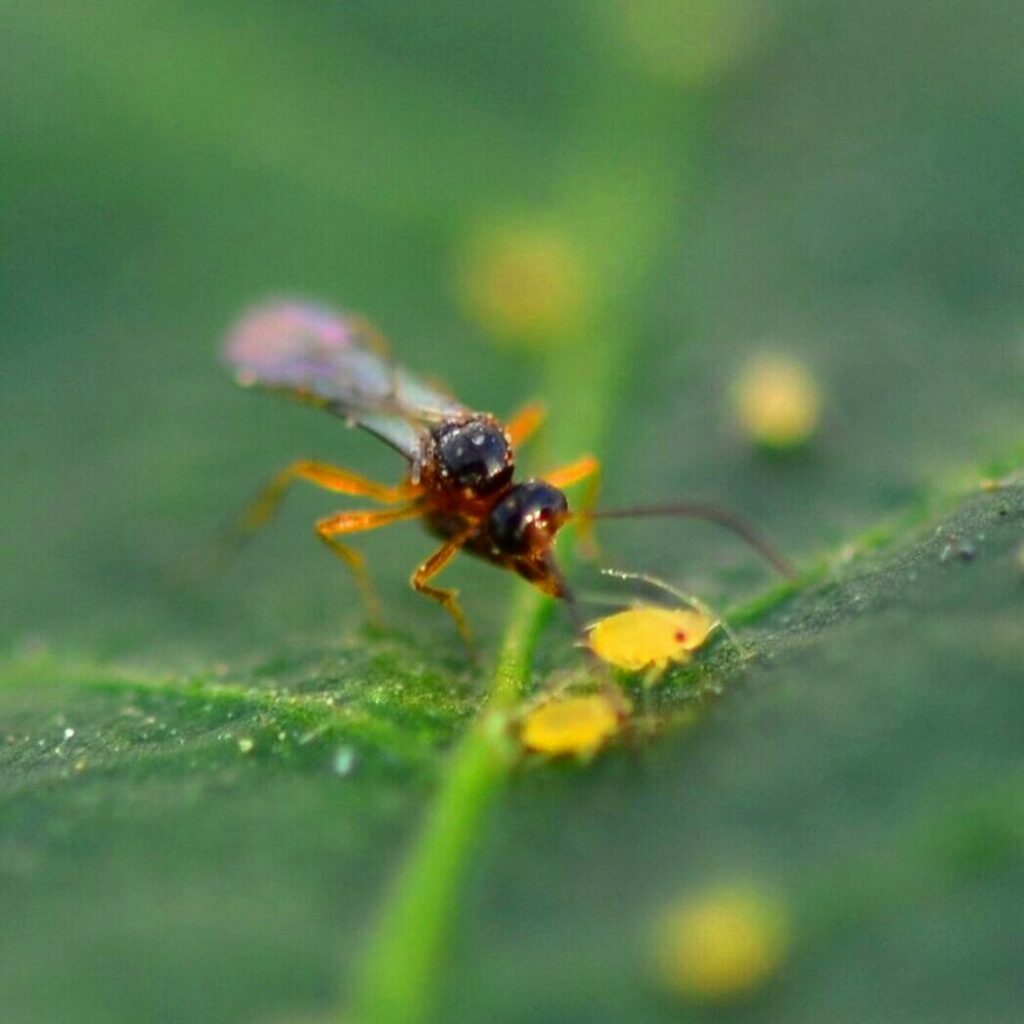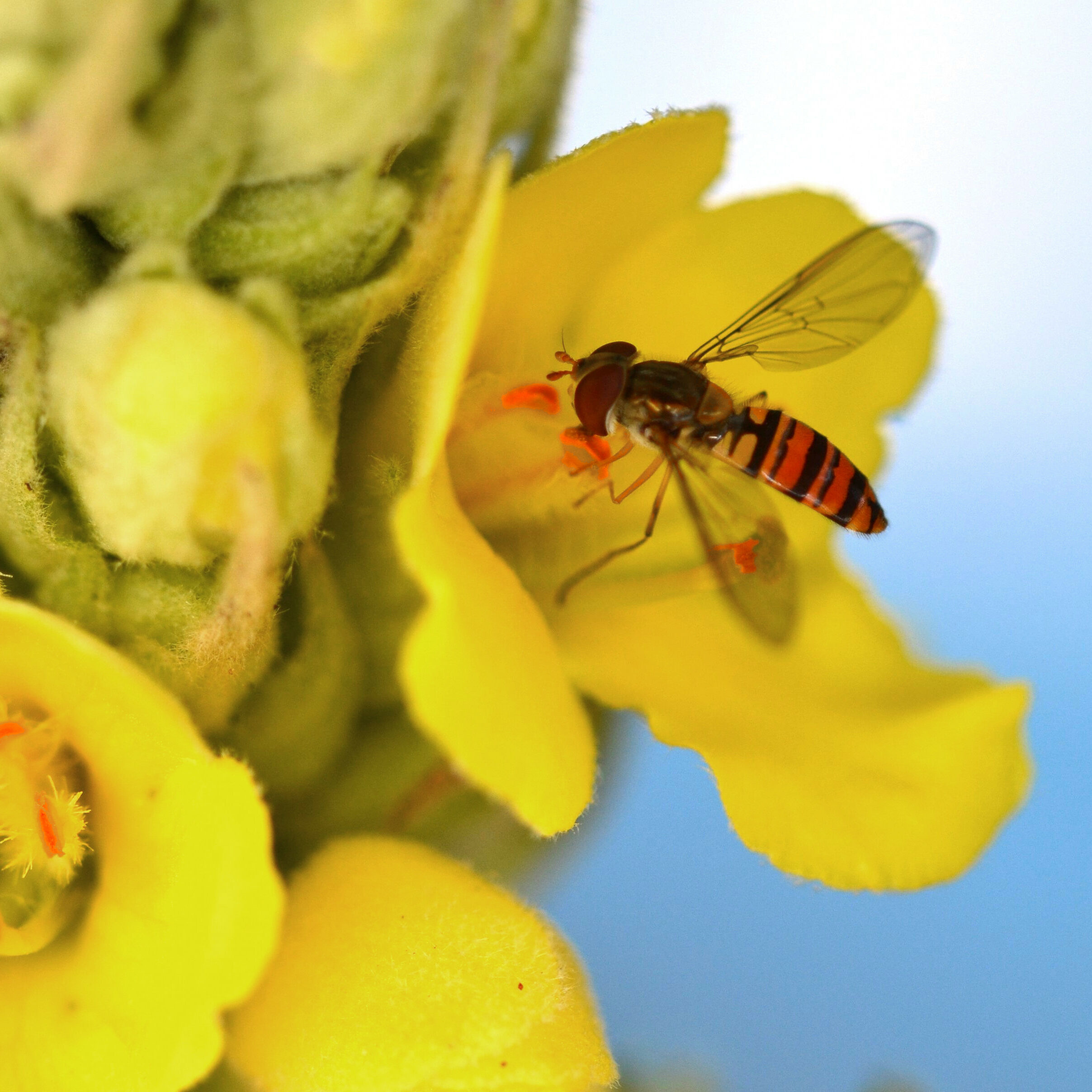Targeted stimulation of beneficial insects for agriculture
What is the project about?
In our project, we specifically focus on supporting insects that provide essential services for agricultural production.
Why do we need targeted insect support for agriculture?
As the largest land user in Germany, agriculture offers habitats for many species that are often reliant on the agroecosystem. Intensive agriculture, with its cleared-out landscapes and its use of pesticides, has put these species under pressure. As a result, in recent decades insect biomass has decreased by more than 75%. Since insects serve as food for many vertebrates, and given that many plants are dependent on pollination by insects as well as insects „clean up“ our environment, it is of vital importance to counteract the decline of insect biodiversity and insect biomass.
The loss of insects in the agricultural landscape, is not only harmful to nature, it also undermines agricultural productivity. Crop production is dependent on the ecosystem services provided by insects, such as pollination and natural pest regulation. Loss of pest control services is particularly detrimental as it leads to further dependence on insecticides. Their increased use in turn leads to the development of resistance, thus for even more insecticide use –The current situation thus creates a vicious circle. Furthermore, insecticides also reach neighbouring and even more distant areas when transported by wind and water. This also endangers organisms that do not directly live in the agricultural landscape.

We therefore need solutions for the agricultural landscape that, on the one hand, address the main factors for insect decline, while also taking agricultural productivity at heart. One way to reduce the use and dependency on insecticides is through the targeted promotion of naturally occurring beneficial organisms. For both conventional and organic farms, it is important that a „standing army“ of pest antagonists is present in order to be able to regulate incoming pests preventively, thereby reducing the need for insecticide applications or other inventions. These pest-regulating insect populations require perennial habitats that provide essential resources such as food, shelter, nursery and wintering habitat. As part of this project, we introduce specific perennial habitats targeted to pest natural enemies, with a focus on perennial beneficial flowering strips (german: Nützlingsblühstreifen, NüBS ).
What are flower strips for biocontrol (german: Nützlingsblühstreifen, NüBS)?
Our flower strips for biocontrol (german: Nützlingsblühstreifen –NüBS-) are mixtures of selected floweringplants sown on agricultural soils along arable crops with a service life of several years. An essential aspect in the choice of flowering plant species used for perennial flowering strips lies in the fact that the selected species not only promote biodiversity in general, but above all support natural enemies of crop pests. Plants are selected that provide these beneficial organisms accessible food, protection and shelter. The crop rotation on the adjacent fields is taken into account as well, by excluding plants that are known to promote relevant pests or pathogens, or that are known to cause weed problems.
Unlike bees, whose dependence on pollen and nectar is commonly known, few are aware that almost all natural enemies, delivering natural pest control, also rely on nectar and pollen as food.


One example is the hoverfly. While their larvae are purely predatory, feeding on aphids and other small pests, the adult hoverflies feed exclusively on nectar and pollen. While nectar serves as the energy source, fueling their flight, the protein-rich pollen is a prerequisite for the female hoverfly to mature its eggs. This means that only when a female hoverfly has consumed enough pollen, she will be able to mature eggs to be laid in aphid colonies in the adjacent crop. There the hatched offspring then help the farmer in controlling (aphid) pests.
The group of insects providing biocontrol services tend to have much shorter mouthparts as compared to honeybees or bumblebees. As a result they need often distinctly different plants for their floral food needs. Those required plants, where the nectar and pollen are for them accessible, they can find in the. From here, the beneficial organisms then migrate to the neighboring crop fields where they provide their natural pest control service. As a result, they can prevent the spread of a pest or by helping to keep pest populations below the damage threshold. By this way these beneficial organisms can provide an alternative to the use of insecticides.
Learning from each other: A look at our European neighbours
Studies in the UK, the Netherlands and Switzerland have shown that such specifically designed flower strips can actually be used to help natural pest control. This reduces the need to use insecticides, which further promotes biodiversity and the ecosystem services provided.
From previous European projects we know that such tailored flowering strips can be successful in agricultural practice. In the Netherlands, for example, where the approach has been implemented for 18 years, insecticide use in conventional wheat and potato cultivation, tailored flower strips have helped to reduce the insecticide use by more than 90 percent. This shows that it is possible to break the insecticide dependence and to generate a positive spiral. The NüBS are thus an important tool in sustainably promoting the ecosystem services provided by insects, while also helping farmers to deal with the loss of plant protection products due to resistance and approval requirements.
At the same time, it was also possible to see that the targeted promotion of beneficial organisms can have significant positive effects on crop yields through improved pollination and natural crop protection. This shows that alternatives to chemical pest control do not have to stand in the way of cost-effectiveness and do not need to compromize yield. The project aims to show solutions for defusing the alleged conflict of interest between nature conservation and agriculture.

Project Profile:
| Project area: | Lower Saxony, Saxony and Thuringia |
| Duration: | August 2020 – July 2026 |
| Total financial volume: | 1.4 Mio. € |
| Coordinating project partner: | Arbeitsgemeinschaft bäuerliche Landwirtschaft (AbL) Mitteldeutschland e.V |
| Partner: | Institute for Plant Protection in Field Crops and Grassland, Julius Kühn-Institut (JKI), Federal Research Centre for Cultivated Plants |
| Funding: | Bundesamt für Naturschutz (BfN) mit Mitteln des Bundesministeriums für Umwelt, Naturschutz, nukleare Sicherheit und Verbraucherschutz (BMUV) sowie Niedersächsisches Ministerium für Ernährung, Landwirtschaft und Verbraucherschutz (ML), Sächsisches Staatsministerium für Energie, Klimaschutz, Umwelt und Landwirtschaft (SMEKUL), Thüringer Ministerium für Umwelt, Energie und Naturschutz (TMUEN), Nordzucker AG und Biobest Group NV |